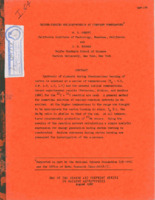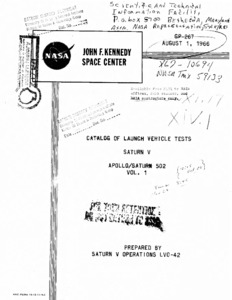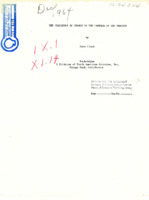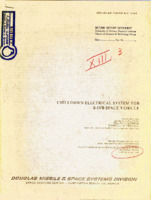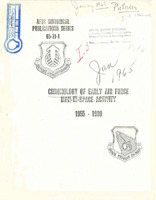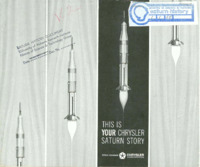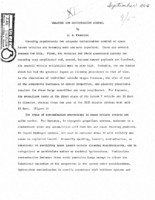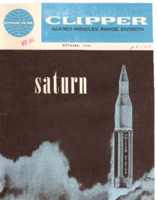
Browse Items (970 total)
Sort by:
-
"Carbon-Burning Nucleosynthesis at Constant Temperature."
"Carbon-Burning Nucleosyntesis at Constant Temperature" is part of the Orange Aid preprint Series in Nuclear Astrophysics, August 1968. The abstract states "Syntesis of elements during thermonuclear burning of carbon is examined at a series of temperatures (T=0.6, 0.8, 1.0, 1.2, 1.4) and for several initial compositions. Recent eperimental results (Ptterson, Winkler, and Zaidins 1968) for the 12C+!@C reaction are used. A general method for numerical solution of nuclear-reaction networkds is described. At the higher temperatures in the range now thought to be appropriate for carbon burning in stars, -
"The Case for Compatibility."
"The Case for Compatibility" is a paper by Robert L. Smith, Jr., who worked in Quality and Reliability Assurance Laboratory at George C. Marshall Space Flight Center. The summary states, "Ever since the use of missiles and space launch vehicles began, questions have existed in every program regarding the similarity between upstream (e.g., manufacturing, static firing ) and launch site checkout equipment. Programs have existed which utilized nearly identical equipment for both uses; other programs have existed in which any resemblance of the equipment was probably coincidental. Many factors have entered the final decisions, not the least of which were economic and schedule considerations, and, in some instances, the organizational structure of the developer." -
Catalog of launch vehicle tests Saturn V : Apollo/Saturn 502 : Volume 1, Section 1.
The document is Volume 1, Section 1 of a list of Saturn V launch tests including but not limited to test titles, test numbers, test objectives, and test descriptions related to AS-502. -
"The Challenge of Change vs the Control of the Process."
The introduction states, "This paper is designed to present the Rocketdyne engine program as it applies to the Saturn launch vehicles and will apply to the Apollo program of manned flight to the moon (Fig. 1). The vehicle that will launch this flight is the Saturn V, the largest and most powerful of the Saturn family. This vehicle, 362 feet tall and 33 feet in diameter, will be capable of sending a 45-ton payload to the moon or placing a 120-ton payload in earth orbit. Five F-1 engines power the first stage of the Saturn V; five J-2 engines, the second stage; and one J-2 engine, the third stage. The thrust of the first-stage engines alone will be equivalent to 160 million horsepower. Both of these engines, the F-1 and the J-2, were designed at, and are currently being produced by Rocketdyne." -
"Chemistry in Space Boosters" presentation given at Huntsville High School.
The document is a draft of the presentation "Chemistry in Space" by Harold Perkins, who explains the role of chemists in developing space launch vehicles. The document Includes references to charts and other presentation supports. The document is marked in the upper left hand corner "Huntsville High School Science Organization (the JETS), October 1962." -
"Chilldown Electrical System for S-IVB Space Vehicle."
The paper is marked, "To be presented at the IEEE 1965 Aerospace Conference featuring Flight Vehicle Electrical/Electronics Systems, Houston, Texas, June 20-24, 1965." The abstract states "This paper presents the electrical system used to drive the chilldown motor pumps on the S-IVB space vehicle. This system consists of a 56 volt battery supplying power to the two three-phase solid state inverters which in turn drive two cryogenic motor pumps. Included in this paper is a short description of the overall chilldown system requirements. The advantages of the a-c system over the d-c system are discussed with emphasis on weight and reliability. Two functionally identical 1.5kva inverters were designed. One inverter uses germanium transistors in the output stage while the other uses silicon transistors. Both inverters were designed to have a quasi-square wave output. The inverter circuitry is described and the advantages of each is discussed including a comparison of weight, size, operating temperature, efficiency and voltage rating." Includes diagrams. -
"Chronology of early Air Force man-in-space activity: 1955 - 1960."
The foreword states "In this chronology, Air Force manned space flight activity is viewed from the perspective of the ballistic missile development agency - the Air Research and Development Command's Western Development Division, later re-named the Air Force Ballistic Missile Division. Due to resource limitations at the Space Systems Division historical office, research for this chronology has been generally limited to materials available in the files of that office. All documents cite in the notes which follow each entry are located in the archives of the Historical Division, Office of Information, Space Systems Division, in Los Angeles California." There are handwritten notes throughout. -
"This is Your Chrysler Saturn Story."
The document is a booklet created as part of the NASA/Chrysler Corporation Space Division manned flight awareness program. It discusses Chrysler's role in manufacturing and testing the Saturn and includes photographs and diagrams of Saturn stages, operations at Michoud, testing, and future missions. The section headings included in this booklet are "Chrysler and the Saturn," "Saturn at Michoud," "The Voyage of Saturn," "Saturn Firings," and "Saturn's Missions." -
"Cleaning and Contamination Control."
The document is a paper describing contamination cleaning methods and advocating for further developments in the field. Tables and figures are included at the end of the paper. The figures include a comparison of Saturn V with Saturn I and Saturn IB and cross-sections of the Saturn C-5, S-IC stage fuel tank assembly and oxidizer tank assembly. -
Guided Missiles Range Division Clipper, vol. 2, no. 3, October 1961.
The Clipper is a Guided Missiles Range Division, Pan American World Airlines, Inc., internal publication. This issue includes the articles "News at a Glance," "The Big One," "New Ships on the Horizon," "Civic Responsibility," "Picture Highlights," "Service Awards," "September Service Pins," and "Recognizing Credit Union." "The Big One" includes details about Pan Am's role in developing the Saturn booster.
